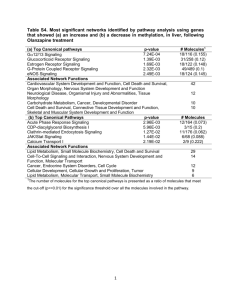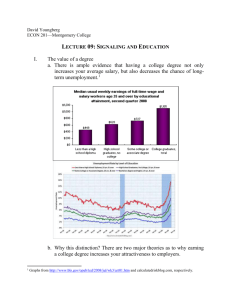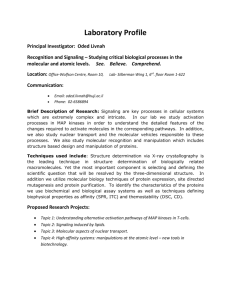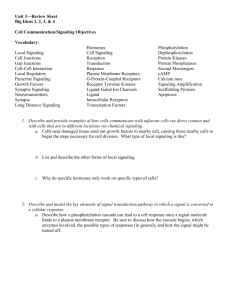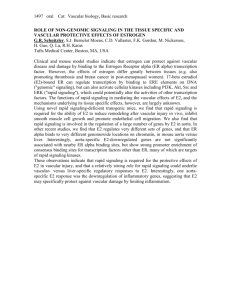5.1. Towards a quantitative understanding of kinase signaling
advertisement
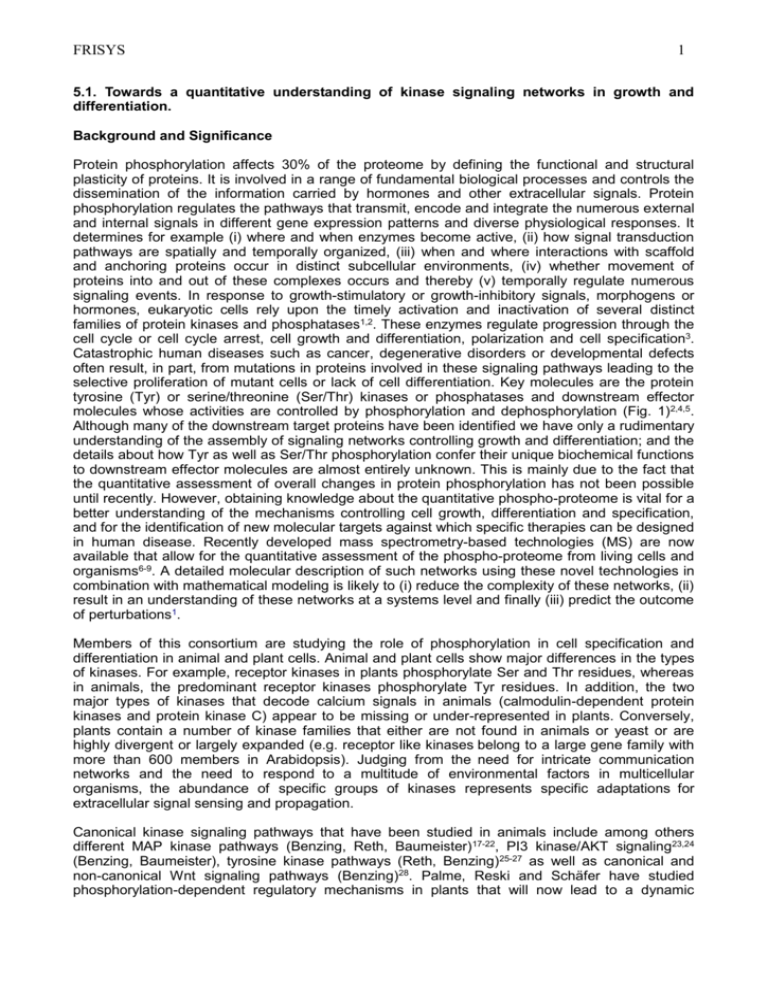
FRISYS 1 5.1. Towards a quantitative understanding of kinase signaling networks in growth and differentiation. Background and Significance Protein phosphorylation affects 30% of the proteome by defining the functional and structural plasticity of proteins. It is involved in a range of fundamental biological processes and controls the dissemination of the information carried by hormones and other extracellular signals. Protein phosphorylation regulates the pathways that transmit, encode and integrate the numerous external and internal signals in different gene expression patterns and diverse physiological responses. It determines for example (i) where and when enzymes become active, (ii) how signal transduction pathways are spatially and temporally organized, (iii) when and where interactions with scaffold and anchoring proteins occur in distinct subcellular environments, (iv) whether movement of proteins into and out of these complexes occurs and thereby (v) temporally regulate numerous signaling events. In response to growth-stimulatory or growth-inhibitory signals, morphogens or hormones, eukaryotic cells rely upon the timely activation and inactivation of several distinct families of protein kinases and phosphatases1,2. These enzymes regulate progression through the cell cycle or cell cycle arrest, cell growth and differentiation, polarization and cell specification3. Catastrophic human diseases such as cancer, degenerative disorders or developmental defects often result, in part, from mutations in proteins involved in these signaling pathways leading to the selective proliferation of mutant cells or lack of cell differentiation. Key molecules are the protein tyrosine (Tyr) or serine/threonine (Ser/Thr) kinases or phosphatases and downstream effector molecules whose activities are controlled by phosphorylation and dephosphorylation (Fig. 1)2,4,5. Although many of the downstream target proteins have been identified we have only a rudimentary understanding of the assembly of signaling networks controlling growth and differentiation; and the details about how Tyr as well as Ser/Thr phosphorylation confer their unique biochemical functions to downstream effector molecules are almost entirely unknown. This is mainly due to the fact that the quantitative assessment of overall changes in protein phosphorylation has not been possible until recently. However, obtaining knowledge about the quantitative phospho-proteome is vital for a better understanding of the mechanisms controlling cell growth, differentiation and specification, and for the identification of new molecular targets against which specific therapies can be designed in human disease. Recently developed mass spectrometry-based technologies (MS) are now available that allow for the quantitative assessment of the phospho-proteome from living cells and organisms6-9. A detailed molecular description of such networks using these novel technologies in combination with mathematical modeling is likely to (i) reduce the complexity of these networks, (ii) result in an understanding of these networks at a systems level and finally (iii) predict the outcome of perturbations1. Members of this consortium are studying the role of phosphorylation in cell specification and differentiation in animal and plant cells. Animal and plant cells show major differences in the types of kinases. For example, receptor kinases in plants phosphorylate Ser and Thr residues, whereas in animals, the predominant receptor kinases phosphorylate Tyr residues. In addition, the two major types of kinases that decode calcium signals in animals (calmodulin-dependent protein kinases and protein kinase C) appear to be missing or under-represented in plants. Conversely, plants contain a number of kinase families that either are not found in animals or yeast or are highly divergent or largely expanded (e.g. receptor like kinases belong to a large gene family with more than 600 members in Arabidopsis). Judging from the need for intricate communication networks and the need to respond to a multitude of environmental factors in multicellular organisms, the abundance of specific groups of kinases represents specific adaptations for extracellular signal sensing and propagation. Canonical kinase signaling pathways that have been studied in animals include among others different MAP kinase pathways (Benzing, Reth, Baumeister)17-22, PI3 kinase/AKT signaling23,24 (Benzing, Baumeister), tyrosine kinase pathways (Reth, Benzing)25-27 as well as canonical and non-canonical Wnt signaling pathways (Benzing)28. Palme, Reski and Schäfer have studied phosphorylation-dependent regulatory mechanisms in plants that will now lead to a dynamic FRISYS 2 characterization of entire phosphoproteomes in differentiating plant cells29-34. Timmer and Backofen have extensive experience in the data-based derivation of models for dynamics of cellular processes37-42. Thus, the foundation of this proposal is a highly interdisciplinary collaboration that brings together developmental and molecular cell biology with biochemistry, molecular medicine, plant physiology, biophysics and computer science. These investigators have a proven record of successful collaboration; and integration of their distinct but complementary disciplines is of central importance to a systems-level, network-biology approach. In this approach functional proteomics will be an essential component to obtain qualitative and quantitative data on the identity of the proteins, their levels and the dynamic changes occurring by modification. The major goals of the proposed project (development of MS-based phospho-proteomics that can be applied to analyze the dynamic and reversible phosphorylation/dephosphorylation events; data analysis to model and predict signaling networks required for growth and differentiation in silico; experimental testing of the obtained hypotheses in well-established model systems; identification of systems properties) will allow to successfully study kinase signaling networks controlling cell growth in animals and plants and to develop a better understanding of the quantitative phosphorylation events governing cell differentiation. Specific Aims This project will generate an internationally competitive unique research platform for phosphoproteomics within ZBSA. Support for instrumentation (i.e. advanced, high performance mass spectrometer) is requested, Major goals of the proposed project are (1) to develop and improve MS-based phospho-proteomics that can be applied to analyze the dynamic and reversible phosphorylation /dephosphorylation events that are required for cell growth and differentiation in different model systems, (2) to use these data to model and predict signaling networks required for growth and differentiation in silico, (3) to test the obtained hypotheses in well-established model systems (such as cultured cells) and organisms (including Caenorhabditis elegans, Xenopus laevis, Arabidopsis thaliana, Physcomitrella patens, zebrafish and Drosophila melanogaster), and (4) to derive the design principles of these networks in terms of regulatory mechanisms, modularity, hierarchy, and robustness. These efforts will be combined with a novel phosphopeptide library-based proteomic screening technology10,11 that has been developed and improved by members of this consortium (Benzing) to simultaneously (1) reveal specific pSer/pThr-binding domains downstream of kinases involved in regulating cell cycle progression and cell differentiation, (2) allow determination of the optimal sequence motifs recognized by the newly-identified domain, (3) provide reagents for biophysical, cell biological, and structural studies of the function of the newly identified domain in the context of cell signaling pathways, as well as reagents for high-throughput screening of the domain for discovery of small molecule inhibitors, and (4) facilitate bioinformatics and systems biology studies to identify downstream targets of the domain that mediate cell growth and differentiation. Specific topics that will be studied include: 1) Hierarchical phosphorylation events in canonical and non-canonical Wnt signaling networks in vertebrates Wnt proteins are secreted glycoprotein ligands that regulate critical aspects of development, including cell proliferation, differentiation, and cell fate43. Wnt signaling regulates these diverse sets of processes through activation of networks of proteins that together regulate the activity of the scaffolding protein Dishevelled44,45. Several divergent cellular pathways exist including the canonical Wnt/beta-catenin signaling46, the non-canonical or planar cell polarity signaling pathway47,48, and the Wnt-Ca(2+)/cyclic guanosine monophosphate pathway49. All these pathways seem to require Wnt-mediated activation of its cellular receptor, a member of the superfamily of Gprotein-coupled receptor Frizzled family, heterotrimeric G proteins and the phosphoprotein Dishevelled. A molecular understanding of the roles of Dishevelled proteins in development is evolving and most recent observations suggest that Dishevelled proteins act as scaffolds essential for Wnt signaling providing docking sites for a diverse and interesting set of protein kinases, phosphatases, adaptor proteins, G proteins, and other proteins such as Axin43. Although the FRISYS 3 components of the canonical Wnt signaling pathway including glycogen synthase kinase 3 (GSK3), casein kinase 1 (CK-1), beta-catenin, and TCF/LEF transcription factors have been studied in detail, the phosphorylation-dependent signaling networks downstream of Dishevelled in noncanonical pathways are less well understood. The Benzing/Walz labs have recently identified a family of proteins that serves as a molecular switch to block canonical Wnt signaling, and promote non-canonical Wnt activation, a pathway that diverges at the level of Dsh28. Non-canonical Wnt signaling requires activation of c-jun N-terminal kinase (JNK) and Rac/Rho GTPases, and involves re-localization of Dsh to the plasma membrane. Using phosphoproteomics technologies we will now study the quantitative changes in protein phosphorylation of downstream components that are required for both the canonical as well as the non-canonical Wnt signaling pathways. To setup mathematical models of kinase signaling networks that are activated through Wnt-induced cellular activation quantitative data on the phosphorylation status of the proteome will be supplemented with kinetic parameters for the individual interactions derived from the phospho-peptide library screens10,11. Since non-canonical Wnt signaling has been shown to enforce the asymmetric distribution of core proteins (including frizzled, Dsh, prickle, strabismus, flamingo, diego) at the plasma membrane in a plane perpendicular to the apical-basal axis, a process called planar cell polarity, we will use Drosophila and zebrafish (Driever lab) to test our models derived from the systems biology approach with a focus on planar cell polarity. 2) Quantitative phosphorylation responses in cell differentiation in the moss Physcomitrella patens In the group of Ralf Reski, a highly sensitive method for the isolation and identification of phosphoproteins has recently been established in the moss Physcomitrella patens29 and is currently successfully applied to the analysis of signal transduction pathways. The merits of this experimental system lie within the feasibility of highly efficient gene targeting in Physcomitrella, a feature being its unique characteristics among plants30. Hence, specific genetic manipulation of identified or predicted phosphosignaling network systems will elucidate their functional implication in fundamental cellular processes like cell cycle control, apoptosis and differentiation events. As stated above kinase signaling is of critical importance in the plant kingdom. These signal transduction elements, however, appear to be substantially different from those of animals. Thus, an uncritical transfer of paradigms derived from research on yeast or mammals towards signaling mechanisms in plants is prone to providing rather inaccurate and misleading results. To date, large scale phosphoproteomics studies on plants are still exceptionally few. Thus, for example, while the impact of MAP kinase cascades on numerous stress signal transduction pathways in plants is widely recognized54, the mechanisms underlying MAP kinase activation are largely unknown, Furthermore, information about phosphorylated substrates of plant MAP kinases is still lacking and only two studies have described the identification of their in vivo target proteins55,56. Progress in the field of phosphorylation-dependent regulatory mechanisms in plants will therefore depend crucially on the identification and dynamic characterization of entire phosphoproteomes which is part of this proposed project. In this project we will focus towards understanding of the mechanisms by which internal and environmental (abiotic and biotic) factors govern Physcomitrella development and control adaptive responses. This will ultimately path the way towards novel strategies in crop improvement and protection. 3) Phosphosignaling networks required for cell differentiation and polarization in Arabidopsis thaliana In the group of Palme components of phosphosignaling networks have been identified which regulate asymmetric subcellular localization of proteins at the plasma membrane34,57-63. Kinases of the widely known AGC family act as a reversible switch that regulate PIN protein localization. In cells where the PID kinase is above threshold levels, PIN is targeted to the apical membrane, whereas in cells lacking PID, PIN proteins accumulate in the cellular basal membrane. Induction of PID in Arabidopsis leads to a quick apical-basal redistribution of PIN, demonstrating the importance of PID for cellular polarity. The availability of components of the protein complexes, knowledge on the dynamic recruitment of certain partner proteins into these complexes and FRISYS 4 information on the role of dynamic modifications such as phosphorylation and ubiquitinylation or hormone signalling will allow to determine the functional relationship amongst them. Through quantitative determination of concentrations of proteins recruited into the functional complexes in space and time it will be possible to generate mathematical models of this system. Furthermore, by simulating and predicting new experiments we will be able to determine the role of certain proteins in the different signalling outputs. In this project we plan to determine the dynamic behaviour of molecular interactions of soluble and membrane located protein kinases, GTPases and other cellular components using a range of advanced microscopic methods to visualize protein networks without disrupting the cellular integrity. Beside analysis in planta we will utilize Arabidopsis protoplasts. The protoplast system will allows expression and analysis of proteins in high-throughput. This is required to build up a dynamic in vivo regulatory network. In addition we will analyze the quantitative changes in protein phosphorylation by mass spectrometric analysis. Results from both approaches will be used to predict and correlate networks with biological function. This will enable us to study the complex dynamic interactions in situ, at light microscopic resolution and obtain information on rates and concentrations using biochemical and mathematical techniques. 4) Phosphorylation signalling for light-regulated development in Arabidopsis thaliana In the group of Schäfer the phytochrome signalling network which controls photomorphogenesis is studied. Phytochromes show a light-dependent nuclear transport64.This light-regulated intracellular localization depends on the phosphatase PAP565. After nuclear import of the photoreceptors a rapid formation of nuclear protein complexes occurs66. These complexes contain besides phytochromes members of the bHLH transcription factor family. Of those PIF3 and others show a very rapid proteasome dependent degradation66. Recently we could demonstrate that the degradation of PIF3 is preceded by a rapid phosporylation, which is dependent on the physical interaction of PIF3 with the phytochromes67. Not only PIF3 but also the photoreceptor phyA shows a rapid degradation after activation. The degradation occurs both in the cytosol and the nucleus. In this project we will analyse the photoreceptor dynamics and PIF3 dynamics( phosphorylation, localization, complex formation and degradation). Based on the measurement of the single reaction components the complex reaction model will be simulated and tested for robustness and additional components 5) Rebuilt kinase signaling pathways for the study of signaling networks in vitro Numerous intracellular signaling elements have been identified in recent years, but their spatial and temporal relationship is poorly understood. Inside the cell signals are processed by a multitude of proteins each of which has its own unique structural and regulatory features as well as different kinetic parameters for signaling. To cope with this complexity, many approaches exist to generate mathematical models of signaling networks. However, a model is only as good as it can be used to make clear predictions about the outcome of a signaling process inside the cell. The Reth laboratory has developed a method that allows the reconstitution of mammalian receptors and their signaling cascades in the genetically distant environment of Drosophila S2 Schneider cells. This synthetic biology approach allows free choice and combination of different components of a signaling pathway. As most cellular signaling processes require a membrane and a normal cellular environment for their proper function, reconstitution of kinase signaling in synthetic biology approaches cannot be done in a test tube. One solution to this problem is the rebuilding of a mammalian signaling pathway in a cell that lacks most components of this pathway. Drosophila S2 Schneider cells are fulfilling these requirements50. These cells can be efficiently cotransfected in a transient manner with up to 15 plasmids each of which carrying a different gene of a signaling pathway51. The transient transfection method used in the S2 reconstitution system allows to analyze in a short time frame many mutants of given signaling proteins. Another advantage of the S2 cell system is, that any Drosophila protein that may interfere with the rebuilt signaling pathway, once identified, can efficiently be eliminated by the RNAi technique, which works very efficiently in FRISYS 5 S2 cells52. The read-outs in this experimental system are protein kinase activation, substrate phosphorylation, protein-protein interaction and signaling complex assembly53. Furthermore, by controlling the protein expression and function in an inducible fashion modification of the kinetic and quantitative parameters of signaling pathways is feasible. At present most signaling studies by genetic means are done by the generation loss of function mutants via RNAi or knock-out technology. These approaches are very important to identify the functional importance of a given signaling element or a given signaling pathway. However, the mechanistic and quantitative aspects of signaling pathways as well as the critical feedback loops, which critically determine their outcome, are hard to study by these loss-of-function approaches alone. Therefore, in this proposed part of the project these studies will be complemented with a synthetic biology and reverse engineering approach that will also be used to verify or falsify existing mathematical models of kinase signaling. Literature: 1. Kuriyan J, Cowburn D. Modular peptide recognition domains in eukaryotic signaling. Annu Rev Biophys Biomol Struct 1997;26:25988. 2. Pawson T, Nash P. Protein-protein interactions define specificity in signal transduction. Genes Dev 2000;14:1027-47. 3. Johnson SA, Hunter T. Kinomics: methods for deciphering the kinome. Nat Methods 2005;2(1):17-25. 4. Pawson T. Protein modules and signalling networks. Nature 1995;373(6515):573-80. 5. Pawson T, Nash P. Assembly of cell regulatory systems through protein interaction domains. Science 2003;300:445-52. 6. Aebersold R, Mann M. Mass spectrometry-based proteomics. Nature 2003;422(6928):198-207. 7. Metodiev MV, Timanova A, Stone DE. Differential phosphoproteome profiling by affinity capture and tandem matrix-assisted laser desorption/ionization mass spectrometry. Proteomics 2004;4(5):1433-8. 8. Gronborg M, Kristiansen TZ, Stensballe A, et al. A mass spectrometry-based proteomic approach for identification of serine/threonine-phosphorylated proteins by enrichment with phospho-specific antibodies: identification of a novel protein, Frigg, as a protein kinase A substrate. Mol Cell Proteomics 2002;1(7):517-27. 9. Kratchmarova I, Blagoev B, Haack-Sorensen M, Kassem M, Mann M. Mechanism of divergent growth factor effects in mesenchymal stem cell differentiation. Science 2005;308(5727):1472-7. 10. Elia AE, Cantley LC, Yaffe MB. Proteomic screen finds pSer/pThr-binding domain localizing plk1 to mitotic substrates. Science 2003;299:1228-31. 11. Elia AE, Rellos P, Haire LF, et al. The molecular basis for phosphodependent substrate targeting and regulation of Plks by the polobox domain. Cell 2003;115(1):83-95. 12. Gavin AC, Aloy P, Grandi P, et al. Proteome survey reveals modularity of the yeast cell machinery. Nature 2006;440(7084):631-6. 13. Yaffe MB. Phosphotyrosine-binding domains in signal transduction. Nat Rev Mol Cell Biol 2002;3(3):177-86. 14. Yaffe MB, Elia AE. Phosphoserine/threonine-binding domains. Curr Opin Cell Biol 2001;13(2):131-8. 15. Pawson T, Gish GD. SH2 and SH3 domains: from structure to function. Cell 1992;71(359-362). 16. Yaffe MB, Smerdon SJ. PhosphoSerine/threonine binding domains: you can't pSERious? Structure (Camb) 2001;9(3):R33-8. 17. Croce A, Cassata G, Disanza A, et al. A novel actin barbed-end-capping activity in EPS-8 regulates apical morphogenesis in intestinal cells of Caenorhabditis elegans. Nat Cell Biol 2004;6(12):1173-9. 18. Benzing T, Brandes R, Sellin L, et al. Upregulation of RGS7 may contribute to tumor necrosis factor-induced changes in central nervous function. Nat Med 1999;5(8):913-8. 19. Benzing T, Gerke P, Hopker K, Hildebrandt F, Kim E, Walz G. Nephrocystin interacts with Pyk2, p130(Cas), and tensin and triggers phosphorylation of Pyk2. Proc Natl Acad Sci U S A 2001;98(17):9784-9. 20. Huber TB, Kottgen M, Schilling B, Walz G, Benzing T. Interaction with podocin facilitates nephrin signaling. J Biol Chem 2001;276:41543-6. 21. Brummer T, Martin P, Herzog S, Misawa Y, Daly RJ, Reth M. Functional analysis of the regulatory requirements of B-Raf and the BRaf(V600E) oncoprotein. Oncogene 2006. 22. Brummer T, Naegele H, Reth M, Misawa Y. Identification of novel ERK-mediated feedback phosphorylation sites at the C-terminus of B-Raf. Oncogene 2003;22(55):8823-34. 23. Huber TB, Hartleben B, Kim J, et al. Nephrin and CD2AP Associate with Phosphoinositide 3-OH Kinase and Stimulate AKTDependent Signaling. Mol Cell Biol 2003;23(14):4917-28. 24. Hertweck M, Gobel C, Baumeister R. C. elegans SGK-1 is the critical component in the Akt/PKB kinase complex to control stress response and life span. Dev Cell 2004;6(4):577-88. 25. Jumaa H, Hendriks RW, Reth M. B cell signaling and tumorigenesis. Annu Rev Immunol 2005;23:415-45. 26. Jumaa H, Mitterer M, Reth M, Nielsen PJ. The absence of SLP65 and Btk blocks B cell development at the preB cell receptorpositive stage. Eur J Immunol 2001;31(7):2164-9. 27. Kersseboom R, Middendorp S, Dingjan GM, et al. Bruton's tyrosine kinase cooperates with the B cell linker protein SLP-65 as a tumor suppressor in Pre-B cells. J Exp Med 2003;198(1):91-8. 28. Simons M, Gloy J, Ganner A, et al. Inversin, the nephronophthisis type II gene product, functions as a molecular switch between Wnt signaling pathways. Nat Genet 2005;37:537-43. 29. Heintz D, Wurtz V, High AA, Van Dorsselaer A, Reski R, Sarnighausen E. An efficient protocol for the identification of protein phosphorylation in a seedless plant, sensitive enough to detect members of signalling cascades. Electrophoresis 2004;25(78):1149-59. 30. Reski R, Cove DJ. Physcomitrella patens. Curr Biol 2004;14(7):R261-2. 31. De Grauwe L, Vandenbussche F, Tietz O, Palme K, Van Der Straeten D. Auxin, ethylene and brassinosteroids: tripartite control of growth in the Arabidopsis hypocotyl. Plant Cell Physiol 2005;46(6):827-36. 32. Paponov IA, Teale WD, Trebar M, Blilou I, Palme K. The PIN auxin efflux facilitators: evolutionary and functional perspectives. Trends Plant Sci 2005;10(4):170-7. 33. Blilou I, Xu J, Wildwater M, et al. The PIN auxin efflux facilitator network controls growth and patterning in Arabidopsis roots. Nature 2005;433(7021):39-44. 34. Friml J, Yang X, Michniewicz M, et al. A PINOID-dependent binary switch in apical-basal PIN polar targeting directs auxin efflux. FRISYS 6 Science 2004;306(5697):862-5. 35. Manning G, Whyte DB, Martinez R, Hunter T, Sudarsanam S. The protein kinase complement of the human genome. Science 2002;298(5600):1912-34. 36. Analysis of the genome sequence of the flowering plant Arabidopsis thaliana. Nature 2000;408(6814):796-815. 37. Hiller M, Huse K, Szafranski K, et al. Single-Nucleotide Polymorphisms in NAGNAG Acceptors Are Highly Predictive for Variations of Alternative Splicing. Am J Hum Genet 2006;78(2):291-302. 38. Siebert S, Backofen R. MARNA: multiple alignment and consensus structure prediction of RNAs based on sequence structure comparisons. Bioinformatics 2005;21(16):3352-9. 39. Hiller M, Huse K, Szafranski K, et al. Widespread occurrence of alternative splicing at NAGNAG acceptors contributes to proteome plasticity. Nat Genet 2004;36(12):1255-7. 40. Schilling M, Maiwald T, Bohl S, et al. Computational processing and error reduction strategies for standardized quantitative data in biological networks. Febs J 2005;272(24):6400-11. 41. Kollmann M, Lovdok L, Bartholome K, Timmer J, Sourjik V. Design principles of a bacterial signalling network. Nature 2005;438(7067):504-7. 42. Schelter B, Winterhalder M, Eichler M, et al. Testing for directed influences among neural signals using partial directed coherence. J Neurosci Methods 2006;152(1-2):210-9. 43. Malbon CC, Wang HY. Dishevelled: a mobile scaffold catalyzing development. Curr Top Dev Biol 2006;72:153-66. 44. Nusse R. Cell biology: relays at the membrane. Nature 2005;438(7069):747-9. 45. Nelson WJ, Nusse R. Convergence of Wnt, beta-catenin, and cadherin pathways. Science 2004;303(5663):1483-7. 46. Brembeck FH, Rosario M, Birchmeier W. Balancing cell adhesion and Wnt signaling, the key role of beta-catenin. Curr Opin Genet Dev 2006;16(1):51-9. 47. Ciruna B, Jenny A, Lee D, Mlodzik M, Schier AF. Planar cell polarity signalling couples cell division and morphogenesis during neurulation. Nature 2006;439(7073):220-4. 48. Darken RS, Scola AM, Rakeman AS, Das G, Mlodzik M, Wilson PA. The planar polarity gene strabismus regulates convergent extension movements in Xenopus. Embo J 2002;21(5):976-85. 49. Kohn AD, Moon RT. Wnt and calcium signaling: beta-catenin-independent pathways. Cell Calcium 2005;38(3-4):439-46. 50. Towers PR, Sattelle DB. A Drosophila melanogaster cell line (S2) facilitates post-genome functional analysis of receptors and ion channels. Bioessays 2002;24(11):1066-73. 51. Rolli V, Gallwitz M, Wossning T, et al. Amplification of B cell antigen receptor signaling by a Syk/ITAM positive feedback loop. Mol Cell 2002;10(5):1057-69. 52. Caplen NJ, Fleenor J, Fire A, Morgan RA. dsRNA-mediated gene silencing in cultured Drosophila cells: a tissue culture model for the analysis of RNA interference. Gene 2000;252(1-2):95-105. 53. Wossning T, Reth M. B cell antigen receptor assembly and Syk activation in the S2 cell reconstitution system. Immunol Lett 2004;92(1-2):67-73. 54. Nakagami H, Pitzschke A, Hirt H. Emerging MAP kinase pathways in plant stress signalling. Trends Plant Sci 2005;10(7):339-46. 55. Andreasson E, Jenkins T, Brodersen P, et al. The MAP kinase substrate MKS1 is a regulator of plant defense responses. Embo J 2005;24(14):2579-89. 56. Liu Y, Zhang S. Phosphorylation of 1-aminocyclopropane-1-carboxylic acid synthase by MPK6, a stress-responsive mitogenactivated protein kinase, induces ethylene biosynthesis in Arabidopsis. Plant Cell 2004;16(12):3386-99. 57. Friml J, Benkova E, Blilou I, et al. AtPIN4 mediates sink-driven auxin gradients and root patterning in Arabidopsis. Cell 2002;108(5):661-73. 58. Friml J, Wisniewska J, Benkova E, Mendgen K, Palme K. Lateral relocation of auxin efflux regulator PIN3 mediates tropism in Arabidopsis. Nature 2002;415(6873):806-9. 59. Galweiler L, Guan C, Muller A, et al. Regulation of polar auxin transport by AtPIN1 in Arabidopsis vascular tissue. Science 1998;282(5397):2226-30. 60. Molendijk AJ, Bischoff F, Rajendrakumar CS, et al. Arabidopsis thaliana Rop GTPases are localized to tips of root hairs and control polar growth. Embo J 2001;20(11):2779-88. 61. Muller A, Guan C, Galweiler L, et al. AtPIN2 defines a locus of Arabidopsis for root gravitropism control. Embo J 1998;17(23):690311. 62. Ottenschlager I, Wolff P, Wolverton C, et al. Gravity-regulated differential auxin transport from columella to lateral root cap cells. Proc Natl Acad Sci U S A 2003;100(5):2987-91. 63. Steinmann T, Geldner N, Grebe M, et al. Coordinated polar localization of auxin efflux carrier PIN1 by GNOM ARF GEF. Science 1999;286(5438):316-8. 64. Kircher, S., Gil, P., Kozma-Bognár, L., Fejes, E., Speth, V., Husselstein, T., Bury, E., Ádam, É., Schäfer, E., Nagy, F. (2002) Nucleo-cytoplasmic partitioning of the plant photoreceptors phytochrome A, B, C, D and E is differentially regulated by light and exhibits a diurnal rhythm. Plant Cell, 14, 1541-1544. 65. Ryu, J. S., Kim, J.-I., Kunkel, T., Kim, B. C., Cho, D. S., Hong, S. H., Kim, S.-H., Piñas Fernández, A., Kim, Y., Alonso, J. M., Ecker, J. R., Nagy, F., Lim, P. O., Song, P. S., Schäfer, E., Nam, H. G. (2005) Phytochrome-Specific Type 5 Phosphatase Controls Light Signal Flux by Enhancing Phytochrome Stability and Affinity for a Signal Transducer. Cell, 120, 395-406. 66. Bauer, D., Viczian, A., Kircher, S., Nobis, T., Nitschke, R., Kunkel, T., Panigrahi, K., Adam, E., Fejes, E., Schäfer, E., Nagy, F. (2004) Constitutive photomorphogenesis 1 and multiple photoreceptors control degradation of Phytochrome Interacting Factor 3, a transcription factor required for light signaling in Arabidopsis. Plant Cell, 16, 1433-1445. 67. Al Sady, B., Ni, W., Kircher, S., Schaefer, E., Quail, P. (2006) Photoactivated phytochrome induces rapid PIF3 phosphorylation as a prelude to proteasome-mediated degradation. Mol. Cell, accepted.

